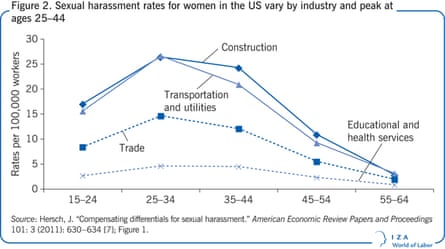Roger Ailes’ departure from Fox News this week has once again put a spotlight on sexual harassment in the workplace. Since a lawsuit was filed accusing Ailes of sexual harassment, more than 20 women have come forward (almost all had experienced it firsthand, but some reached out to lawyers as witnesses).
The issue is a global one. For example, according to the United Nations, “between 40 and 50% of women in European Union countries experience unwanted sexual advancements, physical contact or other forms of sexual harassment at their workplace”.
In America, the best way to understand the prevalence of sexual harassment is to examine data from the Equal Employment Opportunity Commission (EEOC), which are based on events that happen every day in workplaces across the country. Here are some of its findings.
Over half of sexual harassment claims result in no charge
More than half of the allegations of sexual harassment made to the US Equal Employment Opportunity Commission (EEOC) in 2015 have resulted in no charge. The statistics, which span the past six years, show a consistent pattern in which claimants are unsuccessful.
In 2015, the EEOC was asked to investigate 6,822 sexual harassment allegations. Of the cases that were settled last year, the EEOC dismissed 52% since it had “no reasonable cause to believe that discrimination occurred”. A further 25% had a result for the claimant that was deemed positive. These “favorable” outcomes include negotiated settlements, withdrawals of claims but with benefits, successful conciliations and unsuccessful conciliations (the last category means “reasonable cause” was established but there was no conciliation). The remaining 23% of sexual harassment legal claims were simply closed for administrative reasons.
75% of people who experience sexual harassment do not report it
But the latest total to come from the EEOC undoubtedly represents a small fraction of all sexual harassment incidents in US workplaces. Three quarters of individuals who had experienced sexual harassment at work did not report the incident according to a 2013 YouGov/Huffington Post poll. That statistic appears all the more bleak given that a similar survey in 1994 found that an almost identical percentage of respondents (72%) did not report sexual harassment to an employer.
Witnesses are also unlikely to come forward. The 2013 poll found that 23% of people had witnessed sexual harassment in the workplace. Of those, just 33% made a report about what they had seen.
Complaints from men are on the rise
The vast majority of the 2015 EEOC cases were filed by women. Over time, however, the percentage of sexual harassment claims filed by men has risen considerably – 92% of all claims were filed by women in 1990 v 83% in 2015.
The prevalence of sexual harassment varies by industry
A 2011 study published by the American Economic Review Papers and Proceedings used EEOC data together with Census data to look at rates by age group and by sector. It found that women ages 25 to 34 were most at risk and that the construction industry, followed by transportation and utilities, had the highest rates of sexual harassment. The overall numbers are low since they only take into account claims made to the EEOC.

The tech industry also has particularly severe problems according to a report published earlier this year which found that 60% of women working in tech had experienced sexual harassment. The reports authors (themselves women working in Silicon Valley) discovered that, of those who had experienced unwanted sexual advances, 65% of women had been sexually harassed by a superior, and half had received advances more than once. Two out of five of the women interviewed did not report the harassment because they thought it would negatively impact their career.
Those professional consequences also vary by industry. For women who work in the US military, experiencing sexual harassment can result in retaliation which, according to Human Rights Watch, frequently goes unpunished. A separate report by Rand describes the forms that retaliation can take – they include perceived professional retaliation (for example being denied promotion or training), perceived social retaliation (being ignored by coworkers) or adverse administrative actions (such as being transferred to a different assignment).
There’s a clear link between sexual harassment and sexual assault
Most importantly though, the Rand study found a clear link between sexual harassment and sexual assault. US military women who had been sexually harassed in the past year were 14 times more likely to have also been sexually assaulted in the same period (compared to women who had not been sexually harassed). That probability was 49 times higher for men.

Comments (…)
Sign in or create your Guardian account to join the discussion